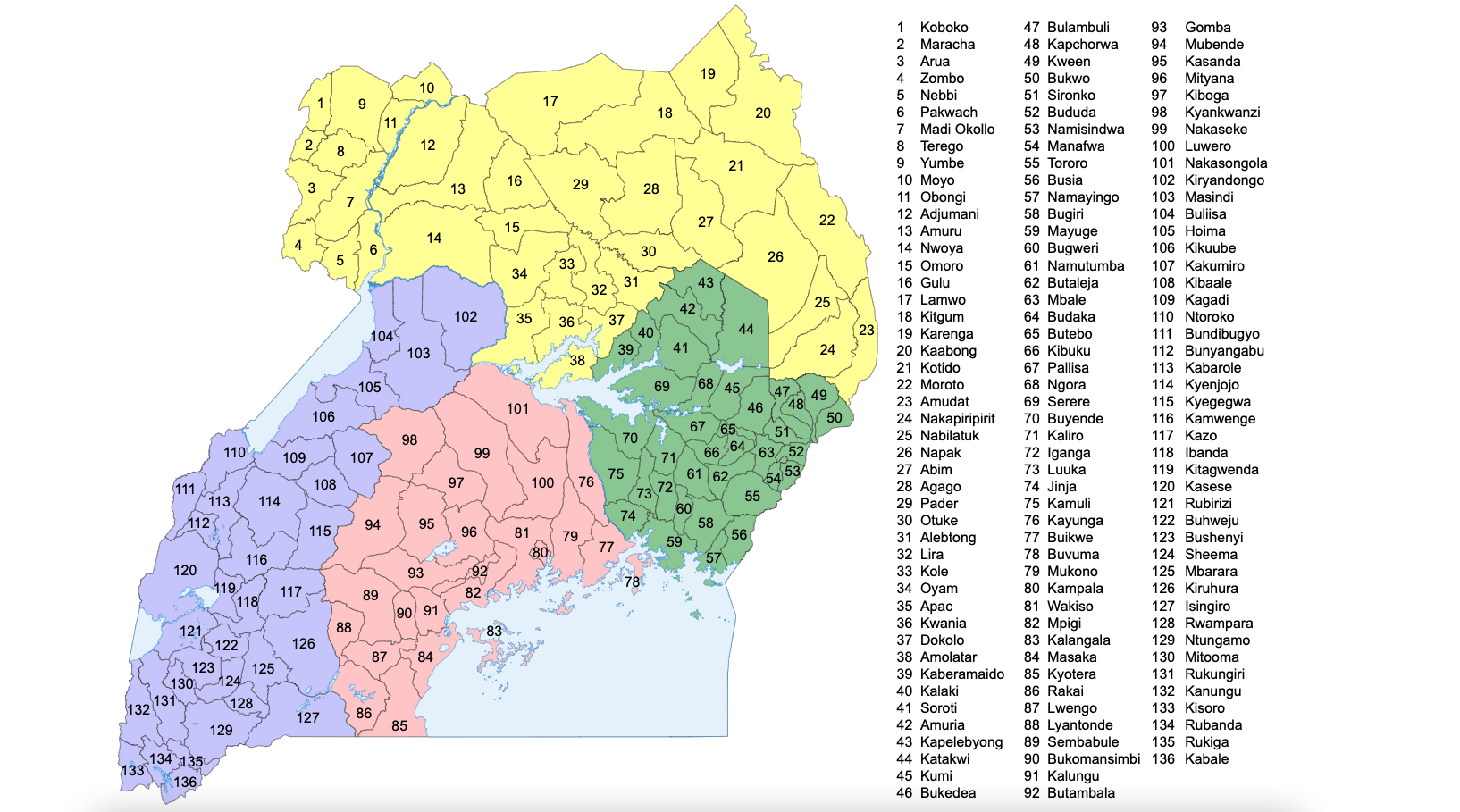|
Majanji
Majanji is a town in the Eastern Region of Uganda. Location Majanji is approximately , by road, south of Busia, the nearest large town and the location of the district headquarters. This is approximately , by road, east of Kampala, the capital of Uganda and its largest city. The coordinates of the town are 0°14'27.0"N, 33°59'29.0"E (Latitude:0.240841; Longitude:33.991387). Overview Majanji sits on the north-eastern corner of Lake Victoria in Uganda, very close to the international border with Kenya. The principal activity in the town is fishing, although the weekly catch has declined due to overfishing. Iglo Foods Fish Factory, a local fish processor, produces only 10 tonnes of fish every week, compared to 40,000 tonnes daily when they first opened in the early 2000s. Population The national census in August 2014 put the population of Majanji sub-county at 11,274. Points of interest The following points of interest lie within the town limits or close to the edges of the tow ... [...More Info...] [...Related Items...] OR: [Wikipedia] [Google] [Baidu] |
Musita–Mayuge–Lumino–Majanji–Busia Road
The Musita–Mayuge–Lumino–Majanji–Busia Road is a road in the Eastern Region of Uganda, connecting the town of Musita in Mayuge District to Busia in Busia District at the international border with Kenya. Location The road starts at Musita, a small town on the Jinja–Iganga road, approximately east of Jinja. The road continues in an easterly direction, through Mayuge, Namayingo, and Lumino. At Lumino, a southern spur, measuring about , goes south to Majanji on the northern shores of Lake Victoria. The main road makes a northerly turn to end at the border town of Busia (2014 population 55,958). The coordinates of the road near Namayingo are 0°22'52.0"N, 33°50'09.0"E (Latitude:0.381111; Longitude:33.835833). Overview The road connects the districts of Mayuge, Bugiri, Namayingo, and Busia. As described, including the spur to Majanji, the entire road project measures . Upgrading to bitumen Before 2015, the road was unsealed gravel surface. In February 2015, the Ug ... [...More Info...] [...Related Items...] OR: [Wikipedia] [Google] [Baidu] |
Busia District
Busia District is a district in the Eastern region of Uganda. Location Busia District borders Tororo District to the north, Busia County, Kenya to the east, amyingoto the south, and to the south-west, and Bugiri District to the west. Busia, Uganda, the site of the district headquarters, is approximately by road south of Tororo, the nearest large town. Population During the 1991 national population census, the population in the district was estimated at 163,600. In 2002, the national census estimated the population at 225,000. In 2012, the mid-year population of was estimated at 297,600. Notable people Notable people from Busia District include: * Aggrey Awori -,Former Uganda Minister of Information Technology (2009-2011) * Barbara Nekesa Oundo, former state minister for Karamoja affairs and the Busia District women's representative in the parliament (since 2011) * Benjamin Joseph Odoki, former chief justice of Uganda * James Munange Ogoola, former principal judge of Ugan ... [...More Info...] [...Related Items...] OR: [Wikipedia] [Google] [Baidu] |
List Of Roads In Uganda
The following is a list of the national roads in Uganda, which are under the jurisdiction of the Uganda National Roads Authority. The list is not exhaustive. National roads See also * Economy of Uganda * Transport in Uganda * Kinshasa Highway References {{reflist, 2 External linksUNRA, World Bank in talks to resume road funding Roads in Uganda |
Busia District, Uganda
Busia District is a district in the Eastern region of Uganda. Location Busia District borders Tororo District to the north, Busia County, Kenya to the east, amyingoto the south, and to the south-west, and Bugiri District to the west. Busia, Uganda, the site of the district headquarters, is approximately by road south of Tororo, the nearest large town. Population During the 1991 national population census, the population in the district was estimated at 163,600. In 2002, the national census estimated the population at 225,000. In 2012, the mid-year population of was estimated at 297,600. Notable people Notable people from Busia District include: * Aggrey Awori -,Former Uganda Minister of Information Technology (2009-2011) * Barbara Nekesa Oundo, former state minister for Karamoja affairs and the Busia District women's representative in the parliament (since 2011) * Benjamin Joseph Odoki, former chief justice of Uganda * James Munange Ogoola, former principal judge of Ugan ... [...More Info...] [...Related Items...] OR: [Wikipedia] [Google] [Baidu] |
Flag Of Uganda
The flag of Uganda ( Ugandan Languages: ''Bendera ya Uganda'') was adopted on 9 October 1962, the date that Uganda became independent from the British Empire. It consists of six equal horizontal bands of black (top), yellow, red, black, yellow, and red (bottom); a white disc is superimposed at the centre and depicts the national symbol, a grey crowned crane, facing the hoist's side. During the colonial era the British used a British Blue ensign defaced with the colonial badge, as prescribed in 1865 regulations. Buganda, the largest of the traditional kingdoms in the colony of Uganda, had its own flag. However, in order to avoid appearing to give preference to one region of the colony over any other, the British colonial authorities selected the crane emblem for use on the Blue ensign and other official banners. History When the Democratic Party ruled the country, a design for flag was proposed. It had vertical stripes of green-blue-green, separated by narrower yellow stripes, an ... [...More Info...] [...Related Items...] OR: [Wikipedia] [Google] [Baidu] |
Uganda
}), is a landlocked country in East Africa East Africa, Eastern Africa, or East of Africa, is the eastern subregion of the African continent. In the United Nations Statistics Division scheme of geographic regions, 10-11-(16*) territories make up Eastern Africa: Due to the historical .... The country is bordered to the east by Kenya, to the north by South Sudan, to the west by the Democratic Republic of the Congo, to the south-west by Rwanda, and to the south by Tanzania. The southern part of the country includes a substantial portion of Lake Victoria, shared with Kenya and Tanzania. Uganda is in the African Great Lakes region. Uganda also lies within the Nile, Nile basin and has a varied but generally a modified equatorial climate. It has a population of around 49 million, of which 8.5 million live in the Capital city, capital and largest city of Kampala. Uganda is named after the Buganda kingdom, which encompasses a large portion of the south of the country, includi ... [...More Info...] [...Related Items...] OR: [Wikipedia] [Google] [Baidu] |
Regions Of Uganda
The regions of Uganda are known as Central, Western, Eastern, and Northern. These four regions are in turn divided into districts. There were 56 districts in 2002, which expanded into 111 districts plus one city (Kampala) by 2010. The national government interacts directly with the districts, so regions do not have any definite role in administration. Under British rule before 1962, the regions were functional administrative units and were called provinces, headed by a Provincial Commissioner. The central region is the kingdom of Buganda, which then had a semi-autonomous government headed by the Kabaka (king). The equivalent of the Provincial Commissioner for Buganda was called the Resident.Uganda Protectorate annual report, Government Printer, Entebbe, 1959 At Uganda's 2002 census, the Central region (It is coterminous with the Kingdom of Buganda, one of the ancient African monarchies that are constitutionally recognised in Uganda) contained 27 percent of the country's populatio ... [...More Info...] [...Related Items...] OR: [Wikipedia] [Google] [Baidu] |
Eastern Region, Uganda
The Eastern region is one of four regions in the country of Uganda. As of Uganda's 2014 census A census is the procedure of systematically acquiring, recording and calculating information about the members of a given population. This term is used mostly in connection with national population and housing censuses; other common censuses incl ..., the region's population was . Districts , the Eastern Region contained 32 districts: External links Google Map of the Eastern Region of Uganda References {{Districts of Uganda Regions of Uganda ... [...More Info...] [...Related Items...] OR: [Wikipedia] [Google] [Baidu] |
Sub-region
A subregion is a part of a larger region or continent and is usually based on location. Cardinal directions, such as south are commonly used to define a subregion. United Nations subregions The Statistics Division of the United Nations (UN) is in charge of the collection, processing, and dissemination of statistical information for the UN. In 1999, it developed a system of macro-geographical (continental) regions, subregions, and other selected economic groups to report advances towards achieving numerous millennial development goals worldwide. These statistical divisions were devised for statistical purposes and is used for carrying out statistical analysis. The division's first publication was the book ''World's Women 2000: Trends and Statistics'' in 2000. According to the UN, the assignment of countries or areas to specific groupings is for statistical convenience and does not imply any assumption regarding political or other affiliation of countries or territories. ... [...More Info...] [...Related Items...] OR: [Wikipedia] [Google] [Baidu] |
Districts Of Uganda
As of 17 November 2020, Uganda is divided into 136 districts and the capital city of Kampala, which are grouped into four administrative regions. Since 2005, the Ugandan government has been in the process of dividing districts into smaller units. This decentralization is intended to prevent resources from being distributed primarily to chief towns and leaving the remainder of each district neglected. Each district is further divided into Counties of Uganda, counties and municipalities, and each county is further divided into Sub-counties of Uganda, sub-counties. The head elected official in a district is the chairperson of the Local Council (Uganda), Local Council five (usually written with a Roman numeral V). Below are population figures from the 2014 census (tables show population figures for districts that existed in 2014). __NOTOC__ Districts created since 2015 In September 2015, the Parliament of Uganda created 23 new districts, to be phased in over the next four years ... [...More Info...] [...Related Items...] OR: [Wikipedia] [Google] [Baidu] |
Busia, Uganda
Busia is a town in the Eastern Region of Uganda. It is the main municipal, administrative, and commercial center of the Busia District, with the district headquarters located there. Location Busia is at the border of Kenya, adjacent to the similarly named town of Busia, Kenya. Busia, Uganda is approximately , by road, east of Kampala, the capital and largest city of Uganda. This is approximately , by road, south of the town of Tororo, the nearest large town in Uganda. The geographical coordinates of Busia, Uganda are 0°28'01.0"N, 34°05'24.0"E (Latitude:0.4669; Longitude:34.0900). Busia, Uganda sits at an average elevation of above sea level. Population In 1969, the national census that year enumerated 1,146 inhabitants in the town. In 1980, that year's census enumerated 8,663 people. According to the 1991 national census, there were 27,967 people in the town. In 2002, the national census that year put the town's population at 36,630. In August 2014, the national population ... [...More Info...] [...Related Items...] OR: [Wikipedia] [Google] [Baidu] |
Kampala
Kampala (, ) is the capital and largest city of Uganda. The city proper has a population of 1,680,000 and is divided into the five political divisions of Kampala Central Division, Kawempe Division, Makindye Division, Nakawa Division, and Rubaga Division. Kampala's metropolitan area consists of the city proper and the neighboring Wakiso District, Mukono District, Mpigi District, Buikwe District and Luweero District. It has a rapidly growing population that is estimated at 6,709,900 people in 2019 by the Uganda Bureau of Statistics in an area of . In 2015, this metropolitan area generated an estimated nominal GDP of $13.80221 billion (constant US dollars of 2011) according to Xuantong Wang et al., which was more than half of Uganda's GDP for that year, indicating the importance of Kampala to Uganda's economy. Kampala is reported to be among the fastest-growing cities in Africa, with an annual population growth rate of 4.03 percent, by City Mayors. Mercer (a New York- ... [...More Info...] [...Related Items...] OR: [Wikipedia] [Google] [Baidu] |





